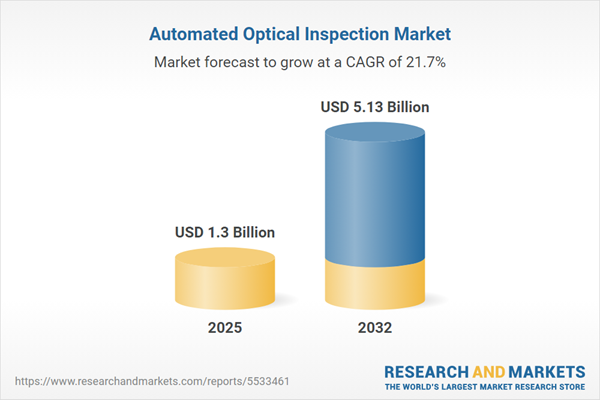Speak directly to the analyst to clarify any post sales queries you may have.
Automated optical inspection has become a strategic focus for manufacturers striving to enhance quality control and operational efficiency in increasingly complex production environments. As electronic assemblies grow smaller and component densities rise, the ability to identify defects rapidly and accurately is pivotal to staying competitive in global supply chains.
Market Snapshot: Automated Optical Inspection Market Growth and Outlook
The Automated Optical Inspection Market grew from USD 1.06 billion in 2024 to USD 1.30 billion in 2025. It is expected to continue growing at a CAGR of 21.70%, reaching USD 5.13 billion by 2032. This exceptional expansion is driven by rapid technology advancement, the growing complexity of printed circuit boards, and the need for heightened reliability in global industries.
Scope & Segmentation
- End User Industry: Aerospace & Defense (Avionics, Navigation Systems, Radar Systems); Automotive (ADAS, Body Electronics, Infotainment, Powertrain); Consumer Electronics (PCs & Laptops, Smartphones, Tablets, Wearables); Healthcare (Diagnostic Equipment, Medical Imaging, Patient Monitoring); Telecommunications (Base Stations, Modems, Routers & Switches)
- Technology: 2D and 3D automated optical inspection solutions
- Mounting Type: Surface Mount Technology and Through Hole Technology
- Inspection Stage: Post Reflow and Pre Reflow deployment
- System Type: Inline, Modular, Standalone systems
- Geographic Regions: Americas (North America, Latin America), Europe, Middle East & Africa, Asia-Pacific
- Key Companies: Koh Young Technology Inc., ViTrox Corporation Berhad, Mirtec Co., Ltd., CyberOptics Corporation, Omron Corporation, Test Research, Inc., Camtek Ltd., Saki Corporation, Nordson Corporation, Hanwha Systems Co., Ltd.
Key Takeaways: Insights for Senior Executives
- The adoption of automated optical inspection systems is vital as manufacturer requirements evolve from simple rule-based identification to sophisticated, AI-driven defect classification in highly complex assembly lines.
- Integration with Industry 4.0 technologies is accelerating, as inspection platforms now deliver predictive analytics and facilitate real-time process optimization.
- Automation providers are investing in flexible, modular architectures that enable fast line reconfiguration, supporting manufacturers aiming to shorten production cycles while maintaining stringent quality thresholds.
- AI and deep learning enhance detection capabilities, reducing false positives and false negatives, which directly impacts production yields and operational costs.
- Cross-regional collaboration and local partnerships are increasingly used to mitigate risks in international supply chains and to uphold consistent inspection performance in diverse regulatory environments.
Tariff Impact: United States Policy Shifts Reshape Global Strategies
Tariff adjustments in the United States during 2025 have driven significant changes in sourcing strategies for inspection hardware and optical components. Procurement teams are shifting toward nearshoring and multi-sourcing, while suppliers focus on localizing assembly and strategic alliances to minimize uncertainty. These adaptations enhance resilience, lower lead times, and stabilize costs amid evolving regulatory demands, reinforcing supply chain agility as a core priority for stakeholders.
Methodology & Data Sources
The report applies a dual-phased research approach that combines primary interviews with industry leaders and technical specialists, alongside rigorous secondary data analysis of journals, white papers, and patent filings. All quantitative findings are cross-validated, and a peer review process was conducted to ensure analytical accuracy and reliability.
Why This Report Matters
- Supports C-level leaders and quality managers in benchmarking automated optical inspection performance and evaluating supplier risk profiles across key verticals.
- Summarizes actionable strategies for optimizing investment in technology, process automation, and multi-source supply chain planning.
- Provides a clear, segment-specific framework for aligning inspection solutions with product complexity, regulatory mandates, and market expansion objectives.
Conclusion
Automated optical inspection stands at the heart of modern manufacturing transformation. Stakeholders prioritizing innovation, robust supply chains, and skilled workforce development will realize sustained operational excellence as industry requirements continue to evolve.
Additional Product Information:
- Purchase of this report includes 1 year online access with quarterly updates.
- This report can be updated on request. Please contact our Customer Experience team using the Ask a Question widget on our website.
Table of Contents
3. Executive Summary
4. Market Overview
7. Cumulative Impact of Artificial Intelligence 2025
List of Figures
Samples

LOADING...
Companies Mentioned
The key companies profiled in this Automated Optical Inspection market report include:- Koh Young Technology Inc.
- ViTrox Corporation Berhad
- Mirtec Co., Ltd.
- CyberOptics Corporation
- Omron Corporation
- Test Research, Inc.
- Camtek Ltd.
- Saki Corporation
- Nordson Corporation
- Hanwha Systems Co., Ltd.
Table Information
| Report Attribute | Details |
|---|---|
| No. of Pages | 194 |
| Published | October 2025 |
| Forecast Period | 2025 - 2032 |
| Estimated Market Value ( USD | $ 1.3 Billion |
| Forecasted Market Value ( USD | $ 5.13 Billion |
| Compound Annual Growth Rate | 21.7% |
| Regions Covered | Global |
| No. of Companies Mentioned | 11 |









